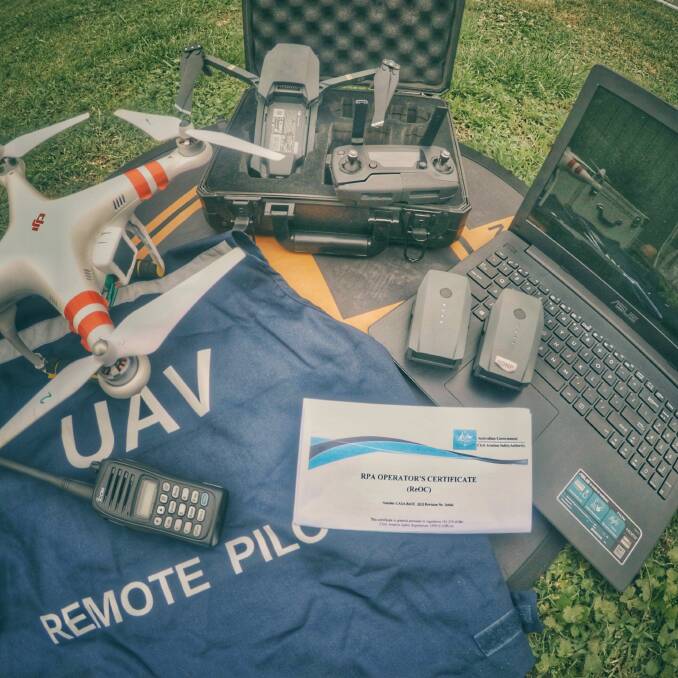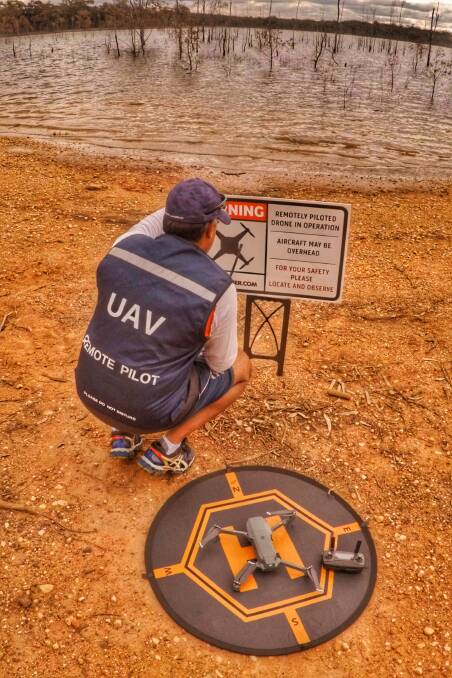WEDNESDAY: CHRIS Mather never intended flying a drone to be anything more than a hobby when he first invested in one of the devices, three years ago.
Subscribe now for unlimited access.
or signup to continue reading
“I just love new technology,” he said.
Armed with one of the first drones on the market – “before GPS was even enabled in these devices” – the web developer would capture photographs and videos of the region.
Chris started publishing his footage via Instagram.
“Then pretty much every week I would get about 10 – 15 requests from people to do it as a business,” he said.
“I told all these people thanks for the offer, but I’m just doing it as a hobby.”
When the Civil Aviation Safety Authority, or CASA, started offering remotely piloted aircraft licences it caught Chris’s interest.
“I ended up in the course last year,” he said.
He then completed a certificate which enabled him to operate commercially as a drone pilot.
In doing so, he has to adhere to certain restrictions and protocols, including job safety assessments.
While the rules and regulations he has to adhere to as a commercial drone pilot differ from those who are doing it for fun, Chris said drone operators of all descriptions needed to be mindful of how they were using the devices.
“Everyone’s got a drone, but lots of people don’t understand the full legal situations with the drone,” Chris said.
“It’s best to check on the CASA website just to make sure you can fly in your area.”
He said some of the most important rules for people with drones to consider were not to fly within 30 metres of people, or in a populous area.
“Also, staying out of airports,” Chris said.
To him, the decision to invest thousands of dollars in drone piloting qualifications was motivated by safety concerns.
“You don’t want to hurt anyone, and you definitely don’t want to disturb the airspace you’re in,” Chris said.
“That way you can enjoy what you’re doing, take photos and be safe at the same time.”
The combined cost of the remote pilot licence and the operator’s certificate exceeded $4000.
Though Chris will be using his skills as part of a business, he said making money from flying drones was not his first priority.
He expects to be working pro-bono for the first quarter of the year.
“I’m going to start off with some of the people I promised footage for the next three months and see where the business goes,” Chris said.
He has extended an offer online for businesses to contact him if they are in need of aerial footage, for free.

Though he has been flying drones for three years, Chris said he was constantly learning.
The learning process has been shaped by the advancements in technology.
“It’s a new industry, new technology… it’s always changing,” Chris said.
GPS capabilities in drones have become so sophisticated, Chris said the devices could target certain points of interest.
Models can be equipped with 3D imaging, infrared imaging and area mapping capacities.
“It’s not just the drone, it’s the software that goes with it as well,” Chris said.
It was when the footage was viewed on a computer that its potential was truly evident.
“On the post-editing side, all of the colours come through,” Chris said.
To maximise the colours in his footage, Chris said he would aim to shoot at either sunrise or sunset.
“At about 400 feet it’s absolutely incredible,” he said.
“It brings out all the colours, all the textures in the sky, and you get that clear image.”
Going out to film has become a family activity, which the 42-year-old Bendigo resident’s young children share in.
“They’ve got their own little wooden drones,” Chris said.
The locations for his 2017 footage were largely determined by features he’d either, or heard might make for good footage.
“From the ground you can never really tell, but from above you can get so many different angles,” Chris said.
Becoming qualified has opened up new shooting locations to him, external to the region.
But Chris identified Castlemaine, Maldon and Echuca as areas of interest for his 2018 show reel.
The former Melbourne resident has called the region home for more than 10 years, and has fallen in love with central Victoira’s lifestyle and natural beauty.
“I just can’t go back,” he said.
- More drone coverage: Drones disappear days after gifted at Christmas
EARLIER: STUNNING central Victorian landscapes have been captured from the air and published for the world to admire, and people are starting to take notice.
A show reel by new business Bendigo Aerial has been viewed almost 6000 times in less than a fortnight.
The visual journey starts at the One Tree Hill Lookout Tower, where the drone can be seen ascending above the treetops.
In the six minutes of footage that follows, viewers gain a birds-eye view of attractions such as Mount Alexander, Hanging Rock, Lake Eppalock and Crusoe Reservoir.
The footage also provides a fresh perspective for often-seen sights.

A sunset casts the Bendigo suburb of Flora Hill in a rose-coloured hue, lighting up the tree canopies and the hills on the horizon.
The towering trees of Campbells Creek Plantation seem to shrink as the drone climbs higher over the landscape, at one point following the road at Faraday.
Trains at the Victorian Goldfields Railway chug through intersections along the track.
Even the canola fields at Daylesford make an appearance.
Chris Mather, of Bendigo Aerial, said the show reel was comprised of footage taken throughout the course of the year.
It took him about two months to sift through more than 740 gigabytes of high-resolution footage, select the clips for the show reel and edit them into a package.
“The hardest part was actually getting it into a that six-minute song,” Chris said.


